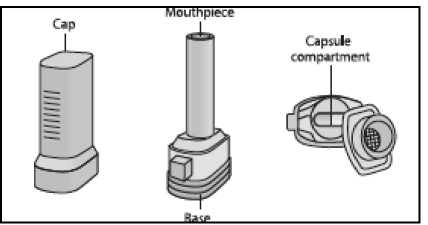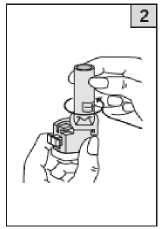Foradil
Out of date information, search another1. What Foradil is and what it's used for
2. Things to consider before you start to take Foradil

3. How to take Foradil
Patient Information Leaflet Foradil® 12 microgram inhalation powder, capsules (formoterol fumarate)
Your medicine is known as the above but will be referred to as Foradil throughout the remainder of this leaflet.
What you need to know about Foradil
Your doctor has decided that you need this medicine to help treat your condition.
Please read this leaflet carefully before you start to take your medicine. It contains important information.
Keep the leaflet in a safe place because you may want to read it again.
If you have any other questions, or if there is something you don't understand, please ask your doctor or pharmacist.
This medicine has been prescribed for you. Never give it to someone else. It may not be the right medicine for them even if their symptoms seem to be the same as yours.
If any of the side effects gets serious, or if you notice any side effects not listed in this leaflet, please tell your doctor or pharmacist.
In this leaflet:
1. What Foradil is and what it's used for
2. Things to consider before you start to take Foradil
3. How to take Foradil
4. Possible side effects
5. How to store Foradil
6. Further information
The Foradil pack includes a blister pack of capsules containing the medicine and an inhaler device for taking the medicine.
Instructions for using the inhaler are given later on in the leaflet.
The active ingredient in this medicine is formoterol. Formoterol is one of a group of medicines called long-acting bronchodilators. It makes breathing easier by relaxing muscle spasms in the air passages of the lungs.
• Foradil is used to treat asthma in people who are already taking inhaled steroids but still have symptoms such as wheezing and breathlessness. Taking Foradil regularly together with inhaled steroids will help to prevent breathing problems
• Foradil is also used to treat breathing problems in patients with chronic obstructive pulmonary disease (COPD)
Some people MUST NOT take Foradil. Talk to your doctor if:
• you know you're allergic to Foradil, or if you have ever had an unusual or allergic reaction to formoterol or inhaled lactose
• you are breastfeeding
Foradil is not suitable for children under six years of age.
The very small amount of lactose in Foradil is unlikely to cause problems in lactose intolerant patients.
You should also ask yourself these questions before taking Foradil. If the answer to any of these questions is YES, tell your doctor or pharmacist because Foradil might not be the right medicine for you.
• Is this the only asthma medicine you have?
• Do you suffer from any heart problems?
• Do you have high blood pressure?
• Do you have an overactive thyroid gland?
• Do you have an aneurysm (area where an artery is swollen because the wall of the artery is weak)?
• Do you have a heart disorder such as abnormal electrical signal called “prolongation of QT interval”?
• Are you diabetic?
• Do you have pheochromocytoma (a tumor of the adrenal gland that can affect blood pressure)?
• Are you pregnant?
Are you taking other medicines?
Some medicines can interfere with your treatment. Make sure your
doctor knows if you are taking any of the following:
• Medicines for heart conditions including irregular heart beats, angina and heart failure
• Medicines for high blood pressure
• Beta blockers (either as tablets or eye drops)
• Water tablets (diuretics)
• Medicines for depression, for example, monoamine oxidase inhibitors (MAOIs) or tricyclics
• Anti-histamines or cold remedies (including any bought from the chemist)
• Medicines called 'steroids'. Your doctor will know which these are
• Sympathomimetic agents, which are adrenaline-like medicines used to treat asthma and nasal congestion
• Phenothiazines, which are a group of medicines which control mental disorders such as schizophrenia, mania, psychotic conditions and anxiety
• Xanthines, for example theophylline or aminophylline, which are a class of medicines used to treat asthma and chronic obstructive airways diseases
• Macrolides (for example Erythromycin) used to treat bacterial infections.
• Anaesthetics like Halogenated hydrocarbons (for example Halothane). These drugs are used to produce anaesthesia during surgery
• Anticholinergic drugs (for example Ipratropium bromide) used to treat gastrointestinal disorders and genitourinary disorders
Always tell your doctor about all the medicines you are taking. This
means medicines you have bought yourself as well as medicines on
prescription from your doctor.
Other special warnings
• You must not use Foradil to treat a sudden asthma attack. Your doctor will have given you another inhaler (a 'reliever') for this
• It is very important to keep using your other asthma medicines, (inhaled steroids known as a 'preventer'), regularly. DO NOT stop using them or change the dose when you start using Foradil
• If you feel that you are getting breathless or wheezy while you are using Foradil, you should continue to use it, but go to see your doctor as soon as possible in case you need another medicine
• T reatment with Foradil may lead to your blood level of potassium becoming too low. This may make you more susceptible to abnormal heart rhythm. Therefore, your doctor may monitor your blood level of potassium, especially if you have severe asthma
• Treatment with Foradil may lead to increased sugar levels in the blood. Therefore, you might need to monitor your blood sugar levels if you are diabetic
Will there be any problems with driving or using machinery?
In some patients, Foradil has been reported to cause dizziness. If you feel dizzy, do not drive or operate machinery.
The doctor will tell you how much Foradil to take and when to take it. Always follow his/her instructions carefully. The dose will be on the pharmacist's label. Check the label carefully. If you are not sure, ask your doctor or pharmacist. Keep using the inhaler for as long as you have been told unless you have any problems. In that case, check with your doctor.
Foradil capsules must only be used with the inhaler provided. You must not try to inhale them using another inhaler. Also, do not put other types of capsules into the inhaler supplied with Foradil.
• Do not swallow the capsules. The contents of the capsule must be inhaled using the inhaler provided
For the treatment of asthma Adults and the elderly
• The usual dose is 1 puff (1 capsule=1 puff) morning and evening
• The usual dose for more severe cases is 2 puffs (2 capsules) morning and evening
• You should not take more than 4 capsules in a day Children aged 6 and over
• The usual dose is 1 puff (1 capsule=1 puff) morning and evening
• A child should not take more than 2 capsules in a day.
When you have asthma you must also be taking an inhaled steroid at the same time as Foradil.
For the treatment of COPD (Chronic Obstructive Pulmonary Disease)
Adults and the elderly
• The usual dose is 1 puff in the morning and evening
Children under 18
• Not applicable
The effects of this medicine will normally last for 12 hours. If you do get attacks of wheezing between doses, do not take extra doses of Foradil. Your doctor will have prescribed another medicine for this purpose. If you are not sure about this, check with your doctor.
• Do not stop or reduce the dose of Foradil or any other medicine for your breathing just because you feel better, without talking to your doctor first. It is very important to use these medicines regularly
• Do not increase your dose of Foradil without talking to your doctor first
• If you feel sick or very shaky or if you have an unusually fast heart beat, your Foradil dose may be too high. Tell your doctor as soon as possible
How to use the capsules with the inhaler device
A child should be shown how to use the inhaler correctly and should only use it with the help of an adult.

1 Pull off the cap.

2 Hold the base of the inhaler firmly and turn the mouthpiece in the direction of the arrow on the bottom of the mouthpiece to open.

